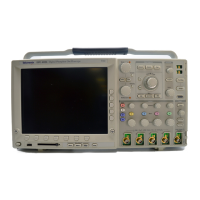The trigger event. The trigger event establishes the time-zero point in the waveform record. All waveform record data are
located in time with respect to that point. The instrument continuously acquires and retains enough sample points to fill the
pretrigger portion of the waveform record (that part of the waveform that is displayed before, or to the left of, the triggering event
on screen).
When a trigger event occurs, the instrument starts acquiring samples to build the posttrigger portion of the waveform record
(displayed after, or to the right of, the trigger event). Once a trigger is recognized, the instrument will not accept another trigger
until the acquisition is complete and the holdoff time has expired.
What do you want to do next?
Learn about trigger sources.
Learn about trigger types.
Learn about trigger modes.
Learn about trigger holdoff.
Trigger sources
The trigger source provides the signal that triggers acquisition. Use a trigger source that is synchronized with the signal that you
are acquiring and displaying.
NOTE. This online help supports many oscilloscope models from Tektronix. Some of these sources may not be available on your
instrument. Some of the sources may not be available on your instrument with its current setup.
You can derive your trigger from the following sources:
■
Input channels. These are the most commonly used trigger sources. You can select any one of the four input channels.
The channel that you select as a trigger source will function whether it is displayed or not.
■
Digital channels. These sources are available on MSO instruments. You can select any combination of digital channels.
■
Bus. This source is used to trigger a parallel bus or a serial bus. You can include any combination of analog, math, or digital
channels to build a parallel bus with up to 20 bits (and a clock), or use any channel as a component in a serial bus. You
define the trigger as a bus pattern for parallel buses or as a bus cycle for serial buses.
■
AC Line Voltage. This source is often used to look at signals related to the power line frequency (for example, signals from
devices such as lighting equipment and power supplies). Because the instrument generates the trigger from the power line,
you do not have to use a channel input.
■
Auxiliary Trigger. (AUX IN) provides a fifth source that you can use as a trigger input when you need to use the four input
channels for other signals. For example, you might want to trigger on a clock while displaying four other logic signals. To
use the auxiliary trigger, connect the signal to the auxiliary input connector on the front panel. The input connector is not
compatible with most probes, nor can you display the auxiliary trigger signal.
■
iCapture. This source is available on MSO instruments. If you select iCapture in the Vertical menu, you can then select the
iCapture channel as the trigger source.
The trigger level range for the front-panel auxiliary input (Aux In) is adjustable from +5 V to –5 V. The maximum input voltage
depends on the instrument model, check your instrument specifications.
What do you want to do next?
Learn about trigger types.
Learn about trigger modes.
Oscilloscope reference
664 DPO70000SX, MSO/DPO70000DX, MSO/DPO70000C, DPO7000C, and MSO/DPO5000B Series

